Greening It Forward
2023 PSEG ISS Green Teams benefits students, organizations and medical facilities
Posted in: Research, Science and Technology, University
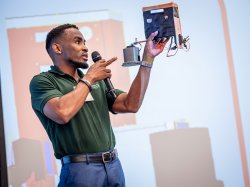
Sara Reper, a senior Sustainability Science major at Montclair State University, passed up an internship opportunity to do outdoor recreation planning in California this summer to participate in the 2023 PSEG Institute for Sustainability Studies (ISS) Green Teams Program. “I’m glad that I did Green Teams instead,” she says.
A junior English major at Montclair, Emily Christian grew up “with a sustainability mindset” near Atlantic City.
“Anything we did in the area I grew up in affected the water, affected the plants, affected the beaches,” she says. “I didn’t know that there was a whole school of thought around sustainability until I received the email about the Institute. So that’s a really big reason why I got involved, because I feel very passionate about it. And I knew that I had skills to bring to the table that aren’t just about my major.”
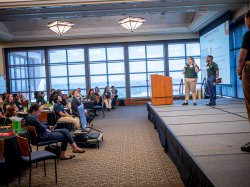
As part of a five-member team, Christian worked on helping University Facilities on improving efficiencies in water usage and reducing waste when students move out of residence halls.
Christian and Reper were among 50 students from 32 universities who participated in this summer’s 10-week Green Teams internship program. Each year, PSEG ISS brings together environmentally conscientious students and organizations to tackle pressing environmental challenges in the community. This year’s students rose to the challenges with which they were presented.
“The PSEG ISS Green Teams interns met a higher bar this year to address the increasingly complex challenges corporations face to reach their climate and energy goals,” says Amy Tuininga, director of the PSEG Institute for Sustainability Studies in the College of Science and Mathematics.
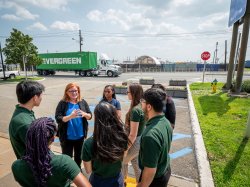
Christian says she wasn’t the only humanities major in the 50-member cohort but she was the only English major. “I would 100% recommend it to anyone but I would say if you’re a humanities major, they need you,” she says. “In order for anything to get done anywhere, you need to make a case for the money. Period. So, if you’re good at persuasive writing, if you’re good at persuasive speaking, if you are good at any type of writing or telling a story, your teammates need you because you’re the yin to their yang.”
Christian used her English expertise to help with writing and editing a script for a short video featuring Montclair pupscot Pebbles for the “Fill it Forward” initiative. She also did the voice-over for the video campaign.
Reper worked to help the Port Authority of New York and New Jersey map fire hydrants and valves for emergency shut off and on modeling energy consumption under different scenarios. Reper says the team’s findings were well received, including a professional presentation at the Port Authority Administration Building in Newark to rank-and-file staff and high-level executives.
She also gained some personal insights. Among her biggest lessons was learning to work in a team. “It’s not necessarily something I’m used to, I’m definitely more of an independent worker. So, learning the patience that I have and the leadership skills that I had or didn’t have was definitely a good takeaway.”
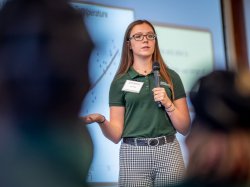
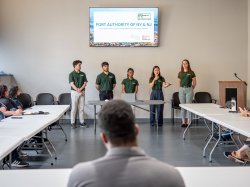
Lastly, she says that the experience gave students new perspectives on areas to increase energy efficiency. In one small example, she says a fellow student pushed the button to automatically open doors to a building, usually used by people in wheelchairs. Another student noted the waste of energy and suggested manually opening the door, to which the student replied, “Oh, I never thought of that.” It was a minor moment of impact, Reper says.
The cohort of Green Teams interns worked on projects for 10 partner organizations. Below are project summaries:
PSEG – This team conducted a competitor analysis of PSEG’s utility and non-utility peers for which they developed key performance indicators, including social impact and sustainability performance. The team also created an overview of the Taskforce on Nature-Related Financial Disclosure framework, providing PSEG with a summary and recommendations intended to inform the company’s financial decision-making based on impacts/dependencies on nature.
dsm-firmenich – The team serving dsm-firmenich worked on improving laboratory sustainability for the scent and flavor manufacturing company by completing several deliverables, including the creation of a Green Lab Challenge and a Green Lab Certification Program to introduce both short- and long-term sustainability solutions. The team also created a Green Chemistry Book in which they recommended alternative chemical reactions, solvents, etc. that would reduce waste and make the company’s laboratory operations more sustainable.
Hackensack Meridian Health – This team worked to recommend best practices for a sustainable transportation program by analyzing the company’s current transportation tracking software and emissions. The team concluded that the majority of emissions came from employees commuting and focused on mitigating employee commute emissions. The team designed a carpool program and public transportation incentives to reduce employees’ reliance on single-occupancy vehicles.
Memorial Sloan Kettering Cancer Center – This team worked on building design recommendations for Memorial Sloan Kettering’s new cancer care pavilion, to be built on Manhattan’s Upper East Side by 2030, to achieve a LEED platinum certification. The team highlighted the health benefits to staff and patients since they would be the primary occupants of the building. The team also presented an Entity Relationship model for a SQL database that could help track environmental metrics for furniture and furnishings purchased by MSK Cancer Center.
Montclair State University Facilities – This team was tasked with helping University Facilities reduce residence hall move-out waste and improve efficiencies on water usage. The team created a short video starring Montclair pupscot Pebbles for the “Fill it Forward” initiative and also made recommendations to replace battery-operated seniors with wired sensors in order to significantly reduce the water usage in campus restrooms.
Newark Community Food System – This team created an urban agriculture social media campaign to improve engagement with the community, alleviate food insecurity, and create awareness regarding the existence of food deserts in the community. The team also organized a “Lettuce Eat Too” community event.
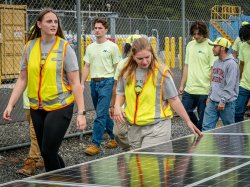
New Jersey Resources – This team focused its efforts on researching and analyzing the food waste landscape in New Jersey and worked toward feasible long-term sustainability initiatives for NJR. The team achieved these goals by examining the current and future potential of vegetative waste in New Jersey and proposing amendments to the state’s recent food waste legislation.
NJ TRANSIT – Using NJ TRANSIT’S waste and recycling data on employee buildings, this team evaluated the overall waste management system and created a way to support future data collection. The team, whose work involved site visits to the Meadows Maintenance Complex, Hilton Bus Garage, General Office Building and Hoboken Terminal.also developed a waste data collection survey and signage to help improve recycling efforts by both employees and passengers. The team’s work will better support the NJ TRANSIT Draft Sustainability Plan.
Port Authority of New York and New Jersey – This team worked on assisting the Port Authority to map assets, such as fire hydrants and below-ground valves in order to shut them off in the event of a leak. After their field work and site visits, the team built a baseline energy consumption model for various buildings. The team’s deliverables will help the Port Authority achieve its goal of reducing emissions by 2030.
Stryker – This team assisted Stryker with identifying financial incentives for renewable energy and energy efficiency through the creation of a database for specific facilities. The team determined, however, that more data is needed to determine the optimal mix of renewable energy procurement for achieving 100% renewable energy by 2027 and being carbon neutral by 2030. To guide data collection and future conclusion of an optimal mix, the team created a framework for future calculations.
Photo Gallery
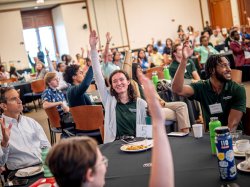
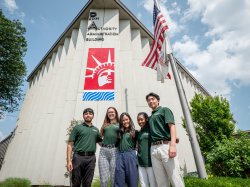
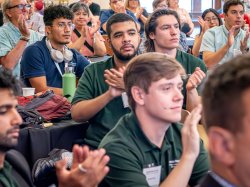
Story by Staff Writer Sylvia A. Martinez. Photos by John J. LaRosa.
To learn more about Green Teams, visit PSEG Institute for Sustainability Studies.
You may also like:
